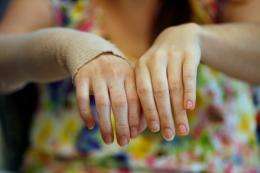UCLA's first hand transplant patient adapting well to new hand

Six-and-a-half weeks after receiving the first hand transplant in the western United States, Emily Fennell is becoming so accustomed to her new right hand that she barely remembers when she didn't have one.
The 26-year-old from Yuba City, Calif., underwent transplant surgery at Ronald Reagan UCLA Medical Center, a 14-hour procedure that began just before midnight on March 4 and concluded at 2:30 p.m. the next day.
"It has been surreal to see that I have a hand again, and be able to wiggle my fingers. My 6-year-old daughter has never seen me with a hand," said Fennell, a single mother. "She looked at it, touched it and said it was 'cool.' "
Fennell was discharged from the hospital April 8 and will continue to stay near UCLA for two months for monitoring and occupational therapy.
"She is making the emotional transition from calling it 'the' hand to 'my' hand," Azari said. "From a surgical standpoint, we achieved a good connection of the nerves and blood vessels, and the balance between the palm and back-of-the-hand tendons appears to be pristine."
Since the transplant operation, the doctors' focus has turned to medically managing a regimen of immunosuppressant medications to help prevent Fennell's body from rejecting the new hand, said Dr. Sue McDiarmid, medical director of the UCLA Hand Transplantation Program, a professor of pediatrics and surgery, and director of the Dumont–UCLA Pediatric Liver Transplant Program.
"Now our goal is provide the right balance of medications to keep Emily's body from rejecting the hand," she said. "We are using a combination of immunosuppressive drugs that should be less toxic for her. Ultimately, we hope that over time we will be able to decrease the dose of her drugs to low levels with minimal side effects, but enough to still protect her from rejecting her new hand."
Another critical element to success is the intensive occupational therapy Fennell will undergo during the first year to help her brain accept the hand and mechanically learn how to use it.
"It's been five years since she used those muscles, and they have atrophied, weakened and shortened," said Renee Portenier, an occupational therapist at UCLA. "Now we have to wake up those muscles again to build strength and neural connections."
Initially after surgery, Fennell underwent therapy twice a day, seven days a week. Currently, as an outpatient, she undergoes four to five hours of rehabilitation five days a week. After a few more months, it will be shortened to three days a week.
The transplant team will closely monitor Fennell's progress and how well her body adjusts to the new hand. As part of this, doctors will map her brain at key points in her recovery, observing which parts light up when she is asked to move her fingers or other parts of the new hand.
Fennell lost her hand after it was crushed in a roll-over car accident in June 2006. She was right-handed prior to the accident. After the amputation, occupational therapists helped her learn how to use her left hand for all tasks, including tying her shoes, writing, dressing and even driving a car. She had tried a myoelectric prosthetic hand, which uses electrical impulses in the muscle, and a traditional "hook" prosthesis, but stopped using those after realizing that they did not provide her the functionality she desired.
But she always missed doing the "little things" that get taken for granted, such as putting her hair in a ponytail or cutting up a steak while dining at a restaurant. She researched hand transplantation and became excited about the possibilities that a new hand could provide, including the potential to provide more fully for her daughter, become more independent and achieve greater success in her career.
"I know it will take time to get there, but my goal is to function like I have two normal hands and not even have to think about it," Fennell said.
Fennell's transplant was made possible by the generosity of the family of a deceased donor in San Diego. The donor's family worked with the staff at Lifesharing, a division of UC San Diego Medical Center, which is a nonprofit, federally designated organ and tissue recovery organization serving San Diego and Imperial counties.
"I cannot thank my donor enough for this amazing gift," Fennell said. "It's helping me feel whole again, and I intend to use it to the fullest."
UCLA is just the fourth center in the nation to perform this procedure and the first west of the Rockies. Fennell's surgery was the 13th of 14 hand transplant surgeries performed to date in the U.S.
A team of 17 surgeons, anesthesiologists, operating room nurses and technicians were involved in the effort. The operation began with two surgical teams working simultaneously to prepare the donor hand and the recipient. At 4:30 a.m. on March 5, four-and-a-half hours after the operation began, the donor limb was joined to the recipient. The surgeons then began the complex work of attaching tendons, blood vessels and nerves to complete the surgery, which concluded at 2:30 p.m.
The transplant surgery was part of an ongoing clinical trial at UCLA intended to confirm that surgical techniques already established in hand transplantation are successful. The trial also aims to study the return of function in transplanted hands and to assess the effectiveness and safety of the anti-rejection medication protocol.



















